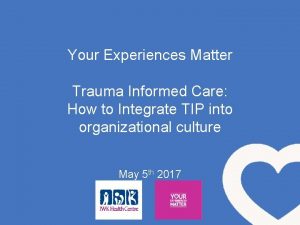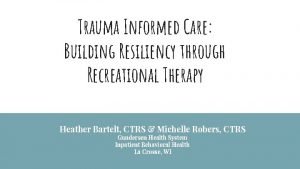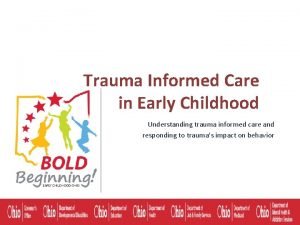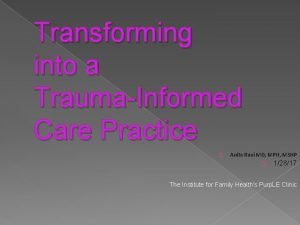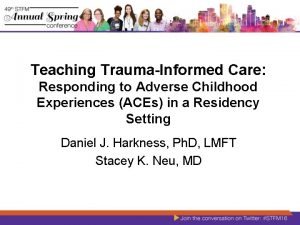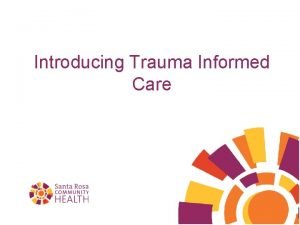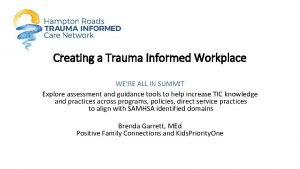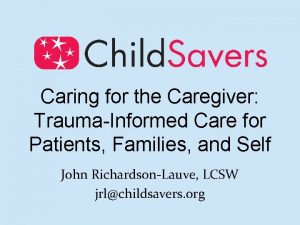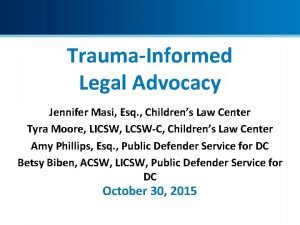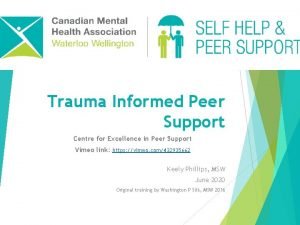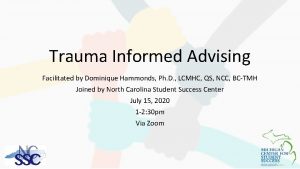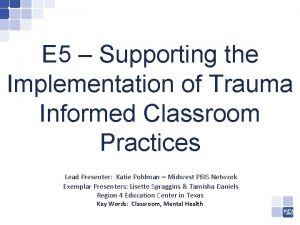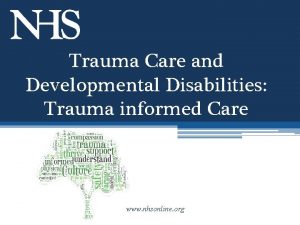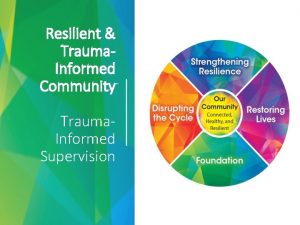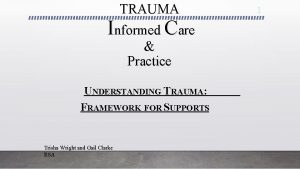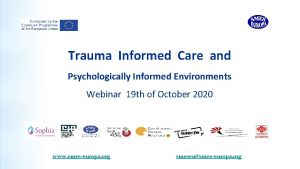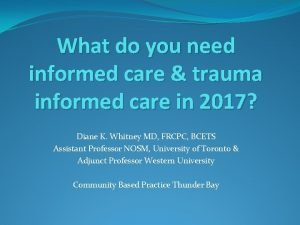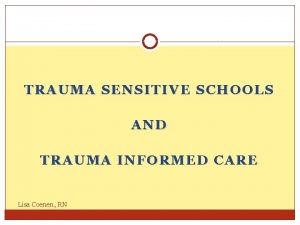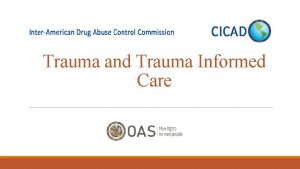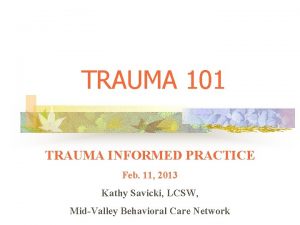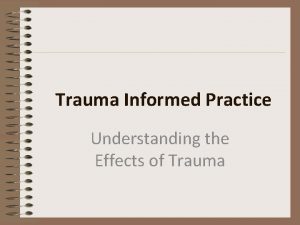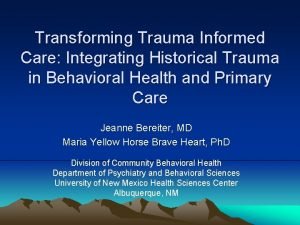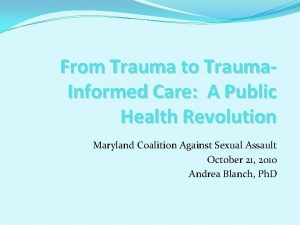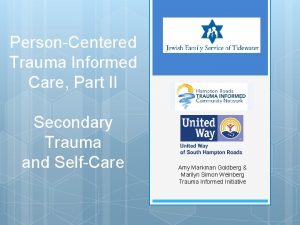Trauma Informed Care and Practice Jodi Nilsson Clinical



















- Slides: 19

Trauma Informed Care and Practice Jodi Nilsson - Clinical Psychologist

What is Complex Trauma? Complex trauma is: • physical, emotional, sexual abuse • Community or family violence • Natural disaster • Chronic illness • Grief • Exposure to war All are overwhelming emotional experiences. These can not be easily integrated (think processed) and lead to dysregulated survival response.

Key concepts � Integration The flow of information through the senses into through the body into the mind, it’s processing and then subsequent flow of information out of the body � Regulation and dysregulation Regulation is the way in which we moderate and manage our emotional input and output Dysregualtion is when this system is overwhelmed and is not able to adequately integrate our experience. FEAR

Survival response � Fight or flight � Sympathetic nervous system � Automatic, whole body response geared for surviving in different environmental conditions � This is a response to fear

Trauma and the Brain When exposed to an overwhelming emotional event: • • The amygdala acts to protect – short term Stops message being sent to frontal cortex Stops message to hippocampus (stops memories) Amps up message to the hypothalamus to go into fight/flight/freeze/flop This is an automatic process that stops ‘rational thought’, overrides the ability to communicate and stops the brain from remembering

Effects of Trauma Interrupts normal development Social - unable to form and maintain relationships Emotional – problems with regulation Cognitive – slower processing, attentional problems, memory disrupted Physical – ACE study

Normal adolescent development Normal adolescents have not developed their pre frontal cortex, they rely on their limbic system – emotional and reactive leading to impulsivity and ‘poor decision making’ Cultural expectations on behaviour

Consider your own ‘training’ To say please and thank you When are tantrums considered okay? Emotional training form birth

Attachment Nurturing adult attachments provide children with protective, safe havens and secure bases from which to explore and engage with others and their environment (Bowlby 1988) Early care-giving has a long-lasting impact on development, the ability to learn, capacity to regulate emotions and form satisfying relationships (Siegel 2012) Teachers, youth workers and significant adults in a child’s life can provide important attachments for children (Bergin and Bergin 2009, Riley 2010) “The biological function of attachment is survival; the psychological function is to gain security” (Schaffer 2004)

Considering attachment, trauma and development To punish a traumatised young person for their automatic survival behaviour is like punishing an epileptic for a seizure

Plan Regulation, Integration and Connection… 1. Feeling safe and secure physically and emotionally is necessary to regulate 2. Relationships and secure attachments lead to safety an encourage regulation 3. Being able to express what has happened – creating a narrative after events where non-verbal at the time

Plan Safe Places…physically, emotionally and culturally 1. Consistent and stable care giving 2. Boundaries and agreed rules 3. Individual plan to reduce triggers 4. Psycho- education Attunement: when our emotional experience is matched and reflected by a care giver

Plan Regulation… 1. Encourage development of emotional regulation skills 2. Gradual over time, start with noticing emotional states 3. Communication will take time, encourage development of communication skills SHAME: powerful human emotion that results when punished after dysregulating event and breaks relationships

Plan Connection… 1. Unconditional positive regard where possible 2. Reduce punishment and shame 3. Encourage attunement 4. Group sport – role of peers

Know thyself Whose expectations? (is this fair? ) Who am I comparing you to? (is this fair? ) How am I reacting to this?

Meet Dysregulation with Regulation It is normal for staff to feel hurt, abused, angry, frustrated, intolerant, anxious, de-skilled and even frightened. Intense and painful feelings are somehow pushed [or projected] into the staff It is normal to question your own competence and professional worth Self care and self regulation is the key to developing compassion necessary to respond to variety of needs

Whole school approach � Feelings of inadequacy and shame fuel behaviour � Need for in class regulation, empathy and understanding

Summary Complex trauma results in less extensive neural brain development (impacts on learning) : less ability to consciously control sub-cortical responses (reactivity) : less time in more complex ‘relaxed’ or ‘connected’ states (feeling uncomfortable) Overall less ability to self regulate emotionally and less ability to form relationships Relationships are key to learn to regulate. SAFETY is central.

Resources… https: //www. bathspa. ac. uk/media/bathspaacuk/education -/research/digital-literacy/education-resource-introduction -to-attatchment. pdf http: //www. childhood. org. au/searchresults? keywords=Making%20 SPACE%20 for%20 Learning %20 http: //www. blueknot. org. au/ABOUT-US/Our. Documents/Publications/Practice-Guidelines
 Trauma informed practice
Trauma informed practice Trauma informed practice
Trauma informed practice Trauma informed practice
Trauma informed practice 4 r's trauma informed care
4 r's trauma informed care Lgbt trauma informed care
Lgbt trauma informed care 4 r's trauma informed care
4 r's trauma informed care Trauma informed approach
Trauma informed approach 4 r's trauma informed care
4 r's trauma informed care Www.dfps.state.tx.us/training/trauma informed care/
Www.dfps.state.tx.us/training/trauma informed care/ Tina champagne sensory modulation and environment
Tina champagne sensory modulation and environment Trauma-informed care activities for staff
Trauma-informed care activities for staff Trauma informed care for foster youth
Trauma informed care for foster youth Trauma-informed workplace assessment
Trauma-informed workplace assessment Trauma-informed questions for clients
Trauma-informed questions for clients Jennifer masi
Jennifer masi Trauma informed peer support
Trauma informed peer support Trauma informed advising
Trauma informed advising Acessexual
Acessexual Trauma informed physical environment
Trauma informed physical environment Hip fracture clinical care standard
Hip fracture clinical care standard
